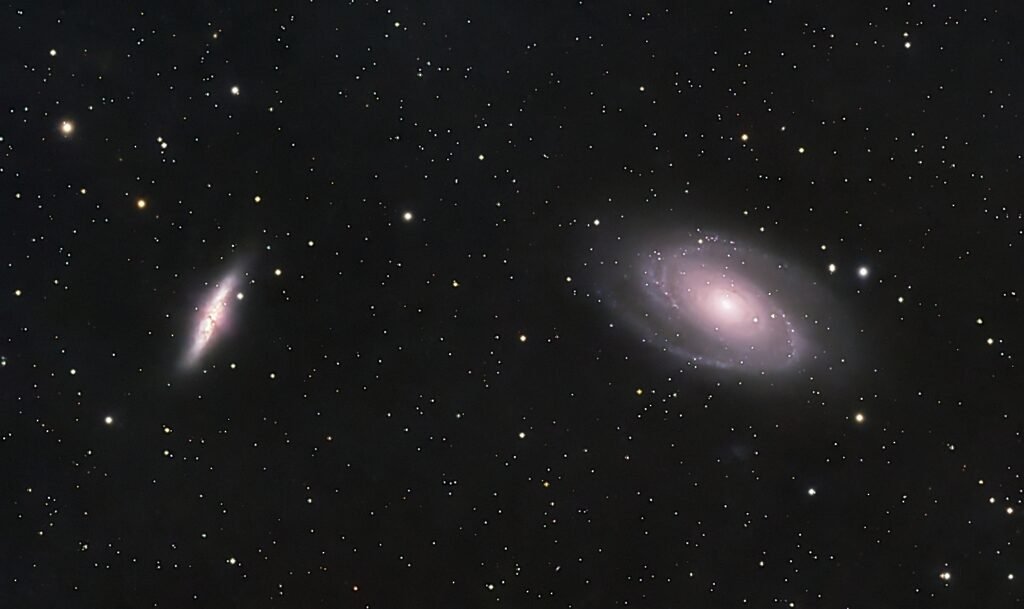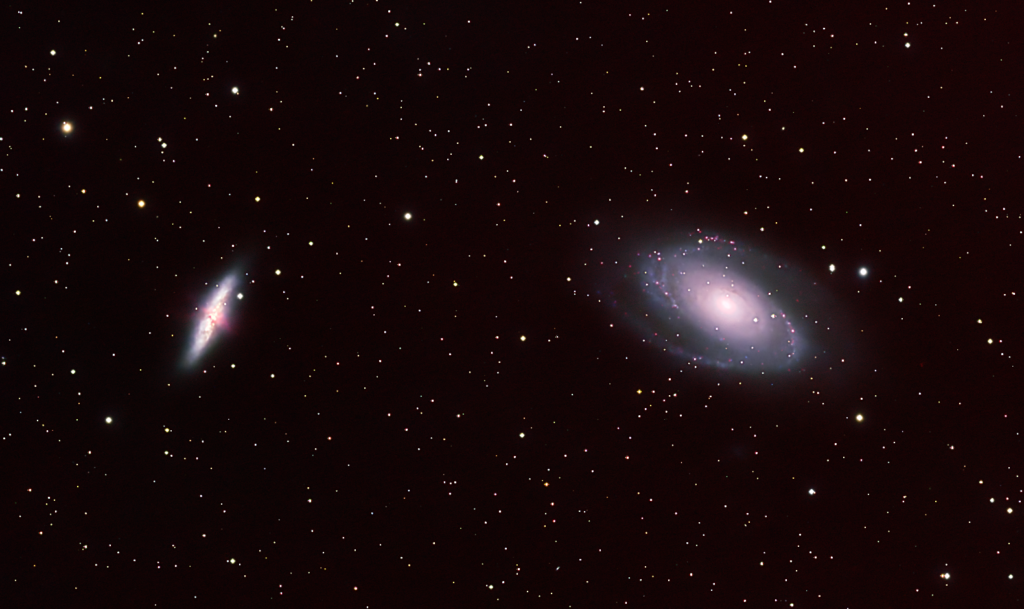Bode’s Galaxy, also known as M81 or NGC 3031, is a well-known spiral galaxy located in the constellation Ursa Major. It is one of the most visually impressive galaxies visible from the Earth and holds significant scientific value in the field of astronomy.
Bode’s Galaxy is situated at a distance of about 12 million light-years from Earth, making it one of the nearest spiral galaxies to our own Milky Way. It has a prominent central bulge and tightly wound spiral arms extending from it, giving it a classic spiral structure. The galaxy has a diameter of approximately 90,000 light-years, making it slightly smaller than the Milky Way.
In terms of its physical characteristics, Bode’s Galaxy is a relatively large galaxy with a high rate of star formation. It contains a vast number of young, hot blue stars in its spiral arms, which contribute to its vibrant appearance. It also hosts a significant number of star clusters, including globular clusters that orbit around its core.
Due to its proximity and brightness, Bode’s Galaxy has been extensively studied by astronomers. It has served as a benchmark for understanding various astrophysical phenomena, including star formation, galaxy evolution, and the dynamics of spiral galaxies. Observations of Bode’s Galaxy have provided valuable insights into the structure and formation of spiral galaxies, helping scientists refine their understanding of the universe.

The galaxies M81 and M82, also known as Bode’s Galaxy and the Cigar Galaxy, respectively, are part of the M81 Group, a small cluster of galaxies located in the constellation Ursa Major. These two galaxies have been observed to have gravitational interactions that have shaped their morphology and influenced their evolution.
The gravitational interaction between M81 and M82 has been studied through various observations and simulations. One significant effect of this interaction is the distorted shape of M82. The tidal forces exerted by M81 have caused M82’s gas and dust to be pulled out of its disk, resulting in an elongated and irregular appearance. This interaction has triggered intense star formation in M82, leading to its status as a starburst galaxy.
A study published in The Astrophysical Journal in 2014 by Niki G. Gómez-Guijarro et al. titled “The Origin of the Extended Hα Filaments in the IC 2574 Tidal Tail” investigated the tidal interactions between M81, M82, and another galaxy called IC 2574. The authors used deep optical and Hα observations to analyze the structure and kinematics of the tidal tails. They concluded that M82 is responsible for the formation of the extended Hα filaments observed in IC 2574, indicating the gravitational influence of M81-M82 interactions on neighboring galaxies.
Furthermore, numerical simulations have been employed to understand the dynamics of the M81-M82 interaction. One study published in The Astrophysical Journal in 2008 by Ji-hoon Kim et al. titled “Formation of Tidal Dwarf Galaxies in Tidally Stripped H I Gas” used numerical simulations to investigate the formation of tidal dwarf galaxies (TDGs) resulting from the M81-M82 interaction. The authors concluded that the interaction between M81 and M82 could generate tidal forces and tidal tails, which may give rise to the formation of TDGs. TDGs are compact, star-forming objects that are thought to be formed from tidal debris in interacting galaxies.

Overall, the gravitational interactions between M81 and M82 have had a significant impact on the morphology, star formation activity, and dynamics of these galaxies. The tidal forces have distorted the shape of M82 and triggered intense starburst activity. The study of these interactions provides valuable insights into the evolution of galaxies in cluster environments and the role of gravitational interactions in shaping galactic structures.

References:
- Niki G. Gómez-Guijarro et al. “The Origin of the Extended Hα Filaments in the IC 2574 Tidal Tail.” The Astrophysical Journal, 782(2), 96 (2014).
- Ji-hoon Kim et al. “Formation of Tidal Dwarf Galaxies in Tidally Stripped H I Gas.” The Astrophysical Journal, 686(1), 75-88 (2008).